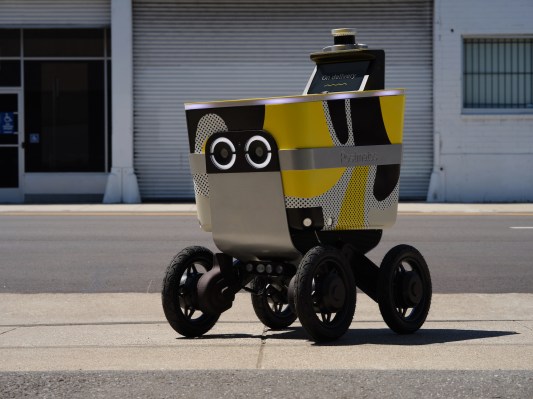Postmates’ cooler-inspired autonomous delivery robot, which will roll out commercially in Los Angeles later this year, will rely on lidar sensors from Ouster, a burgeoning two-year-old startup that recently raised $60 million in equity and debt funding.
Postmates unveiled the first generation of its self-described “autonomous rover” — known as Serve — late last year. The vehicle uses cameras and light detection and ranging sensors called lidar to navigate sidewalks, as well as a backup human who remotely monitors the rover and can take control if needed.
A new second-generation version made its debut onstage earlier this month at Fortune’s Brainstorm Tech event. This newer version looks identical to the original version except a few minor details, including a change in lidar sensors. The previous version was outfitted with sensors from Velodyne, a company that has long dominated the lidar industry.
The supplier contract is notable for Ouster, a startup trying to carve out market share from the giant Velodyne and stand out from a global pack of lidar companies that now numbers close to 70. And it could prove substantial for the company if Postmates takes Serve to other cities as planned.
Lidar measures distance using laser light to generate highly accurate 3D maps of the world around the car. It’s considered by most in the self-driving car industry a key piece of technology required to safely deploy robotaxis and other autonomous vehicles.
Ouster’s strategy has been to cast a wider net for customers by selling its lidar sensors to other industries, including robotics, drones, mapping, defense, building security, mining and agriculture companies. It’s an approach that Waymo is also pursuing for its custom lidar sensors, which will be sold to companies outside of self-driving cars. Waymo will initially target robotics, security and agricultural technology.
Ouster’s business model, along with its tech, has helped it land 437 customers to date and raise a total of $90 million.
The contract with Postmates is its first major customer announcement. COAST Autonomous announced earlier this week that it was using Ouster sensors for its a low-speed autonomous shuttles. Self-driving truck companies Kodiak and Ike Robotics have also been using the sensors this year.
Ouster, which has 125 employees, uses complementary metal-oxide-semiconductor (CMOS) technology in its OS1 sensors, the same tech found in consumer digital cameras and smartphones. The company has announced four lidar sensors to date, with resolutions from 16 to 128 channels, and two product lines, the OS-1 and OS-2.
